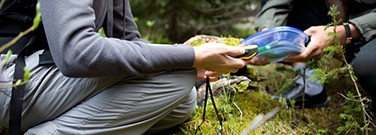Discover Nature and Treasure with Geocaching

By Tom Wright
Spring is here, the sun is out, birds are chirping — it’s a great time to go outside, take a walk, and get some fresh air. If you’ve spent the past year combing the trails of your favorite local park, the paths can become predictable. Why not try new paths or even areas without paths? Welcome to geocaching!
Geocaching is basically a treasure hunt and your smartphone is the map. People have hidden caches around the world just waiting for you to discover. The predictable trails you’ve been hiking may have hidden caches along them for you to find.
Getting Started
An easy way to start geocaching is to download the “Geocaching” mobile app (available through Google Play or the Apple App Store) to your smartphone. Then create a free account, follow the introductory instructions, and choose a geocache in your area that interests you.
When you’ve selected a cache, look at the listing to get an idea of its location and the length of the hike to determine whether it’s within your capabilities. You can also search online for geocaches rather than using the app. When you find one you like, enter the coordinates into your smartphone or GPS unit to figure out how to get there.
Regardless of your method of finding a geocache, you can typically find more details about the cache, including a detailed description of the route, points of interest along the way, hints for finding the cache, a description of the cache itself, and a description of the cache contents.
Grab Your Gear
Prepare for the hike before you start. If the cache is only a short walk from the parking area, the prep is easy. For longer hikes, protect yourself from the elements and the brush. Wear a long-sleeved shirt, pants, hiking boots, and a hat. Take water for hydration, a pen or pencil to sign the logbook, and any trinkets or items that you want to leave behind. A head lamp or flashlight is highly recommended if you may be out after dark. And take any other safety precautions that you would for a normal hike.
If you’re a beginner and using a smartphone, be careful that your hike does not take you beyond your phone’s signal. As you gain experience, try using a dedicated GPS unit for more remote geocaches. As you check to make sure you’re heading in the right direction, be careful. If you’re taking a longer look at your phone, stop walking for a moment to avoid tripping on branches or falling over something on the ground.
Get Outside
Now you’re ready to geocache! Navigate to the latitude and longitude coordinates using your smartphone or GPS unit and start your search. Half the fun of geocaching is finding the spot once you’re in the right area. You’ll have to search for the cache — sometimes it will be hidden in a tree trunk, perched above you on a branch, or concealed in a shrub.
A cache is typically a weatherproof container that contains a logbook. Caches may also contain trinkets, books, pictures, or recipes. Confirm the details of your cache and leave the appropriate items behind. When you find the cache, open it, sign the logbook, and try not to disturb its hiding place or the surrounding area. If the cache contains trinkets, you may take one and replace it with something of equal or greater value.
Some caches even have trackable items that you can take from the cache, log on the appropriate website, and place in a different cache on your next outing. The original contributor can track the progress of the item as it travels. Once you’ve enjoyed your discovery, return the cache to its original location and cover your tracks. Don’t make the cache any easier or more difficult for the next person to find. When you’ve finished, head home or on to the next cache.
Ultimately, geocaching can add a new and fun twist to a traditional hike. It’s a great excuse to get out and enjoy the sunshine while shaking off the winter blues.
Discussion Questions
- How are latitude and longitude measured?
- What is the origin of the GPS system?